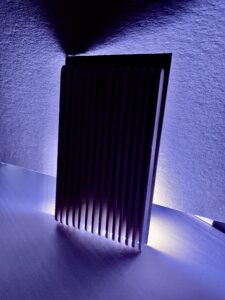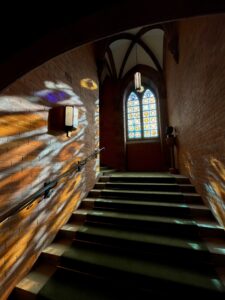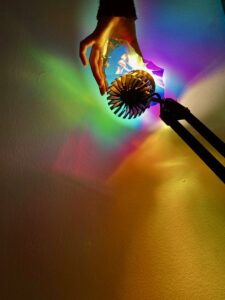Representing light: the paradox
Specifying Light
- show atmospheric light and how you want it to look
- Then show what the light fitting is (most likely won’t be your own drawing)
- Include dimensions
- Technical Sections can check overlapping etc on section and plans
- Locate the drawing
- Sketch drawing set includes: drawn visuals, precedent images, 3D location sketches, sketch design details for luminaires integrated into the architectural fabric
- CAD drawing set includes: RCPs – reflected Ceiling Plans to show layout, setting out, quality of luminaires, switching and control zones, lighting details integrated into the architectural fabric
Reflected Ceiling plan:
- Prepare the background by greying out the architectural space to read as a background only
- Remove doors and include Iintels
- Separate low level and high level drawings may be required to explain lighting layout
- Not necessary to draw luminaires to scale as they must be represented clearly. Linear luminaries should be drawn to scale to ensure some accuracy with length
- Link together luminaires that are to be controlled together, giving them the same control zone number
- Show connection of each zone to a switch, two way switch or a dimmer
Best software: Relux, dialux, Sketchup or radiance
Conclusion:
- good presentation – client recall
- Sketching and computer graphics should not be seen as mutually exclusive
- Sketches are more immediate and less cars in stone – easier to manage client expectations
- With virtual simulation/photoshop images client may feel that they are seeing a photograph of the finished product. May however help client to visualise the light.
Lighting strategies
The source of light
- natural and artificial
- Natural is unpredictable as we may not know how much sunlight we will get day to day
- Artificial light allows us to create those spaces in a way we want to achieve the effect
- We can control artificial light and measure it as its more of a static source
- Technology changes what we do with lighting
- We can have as much expression in our design with artificial than natural
- OLEDs: An organic light-emitting diode, also known as organic electroluminescent diode, is a light-emitting diode in which the emissive electroluminescent layer is a film of organic compound that emits light in response to an electric current
3 aspects of lighting
- ambient luminance (graded washes)
Wide view of a space, can suggest infinity, ambient background, subtly integrated
E.g. elie tahari retail, the Tate modern, queen Elizabeth olympic park (velodrome and aquatic centre)
TIP: light the vertical plane, 1m-1.5m when sitting or above 1.5m when standing for eye level lighting. A space can feel really gloomy even when its not depending on where the light is at eye level
Wall washer lights recessed into the ceiling or suspended, can give symmetric or asymmetric effects
Linear lights (LEDs or fluorescent)
Note: manufacturers will give a specification so that they aren’t distracting etc and give a smooth effect
Don’t light clear glass – you can edge light or have a fit or a print on the glass so the light catches it and glows
2. Play of brilliants (sharp detail)
Things that make the space more interesting, can be distracting and entertaining
E.g. hydro Glasgow (VIP area), at martins lane hotel London, Mortons club London, hotel Huerta America Madrid
3. Focal glow (highlight)
Draws people into a space or helps with orientation, it tells people what to look at
E.g. Bonham hotel Edinburgh, Yale centre for British art, museum of islamic arts Qatar,
Focal glow as a form giver, understanding where the light is coming from the 3d sculptural effects it gives
Isometric lighting and design
Lighting design Layers – Developing Kelly’s Approach
- General or Ambient Lighting
These are called ‘general’ or ‘ambient’ because they are simply used to make an interior space visible. They provide general lighting for a space and are sometimes used to refer to natural or existing light. Think of general/ambient light as a natural light combines with light coming from normal room lights.
2. Task lighting
Task lighting is directed lighting toward a specific area to give more detail to objects and provide safe passage. Any close-range work such as cooking, sewing, drawing and writing should have task lighting – enough to see a flaw in canvas and clothing. Be aware of specific building functions needing specific task lighting level such as hospital operating theatres, dentist surgery etc
3. Accent Lighting
Accent lighting is used to accentuate features and add visual interest to an object or area. Its the extra special something that makes people go ‘oooh’ and ‘aaah’. Use accent lights to add drama and change the mood of a room
Luminaire Types
- Surface lights
Surface-mounted fixtures are visible and fixed against the ceiling or wall. They are most commonly used in entryways, hallways and public spaces that do not require discreet lighting.
2. Pendant lights
Pendant fixtures hang down from the ceiling by a cord, cable or chain. They are usually found in spaces with higher ceilings.
3. Recessed lights
Recessed lighting is hidden away, usually in a ceiling cavity, so you can’t see the light source directly. This type of indirect lighting, usually in the form of a downlight, can be used to create slots/lines of light. Always be aware of the building fabric you will need to recess into – this is not always possible!
4. Track lights
Track lighting can provide a lot of flexible lighting options. There are multiple luminaires on one track, with multiple control circuits. You can choose to have track surface-mounted, recessed or suspended.




